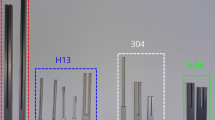Abstract
A central symmetrical design in double ended tuning fork (DETF) resonator is demonstrated to remove the high feedthrough signal. The equivalent electrical simulation model for piezoresistive sensing is first built to illustrate that the location arrangement of connection pads plays a decisive role in the response of the high frequency resonators. Both of the symmetrical design and asymmetrical design of the DETF that resonating at 3.1 MHz are fabricated and tested to verifiy that with the same dimension of the resonator structrue, the symmetrical design can help to cancel the feedthrough signal from the output of the wheastone bridge.





Similar content being viewed by others
References
Agarwal M et al (2007) Acceleration sensitivity in beam-type electrostatic microresonators. Appl Phys Lett 90:014103. doi:10.1063/1.2426884
Arcamone J, Colinet E, Niel A, Ollier E (2010) Efficient capacitive transduction of high-frequency micromechanical resonators by intrinsic cancellation of parasitic feedthrough capacitances. App Phys Lett 97:043505. doi:10.1063/1.3472217
Bontemps J et al (2009) 56 MHZ piezoresistive micromechanical oscillator. In: Solid-State Sensors, Actuators and Microsystems Conference, 2009, TRANSDUCERS 2009, International. IEEE, pp 1433–1436
Faes A, Resta G, Solazzi F, Margesin B (2012) Modeling of gold microbeams as strain and pressure sensors for characterizing MEMS packages. Microsyst Technol 18:1139–1145. doi:10.1007/s00542-012-1457-5
Tang ZY, Fan SC, Xing WW, Guo ZS, Zhang ZY (2011) An electrothermally excited dual beams silicon resonant pressure sensor with temperature compensation. Microsyst Technol 17:1481–1490. doi:10.1007/s00542-011-1319-6
Thaysen J, Boisen A, Hansen O, Bouwstra S (2000) Atomic force microscopy probe with piezoresistive read-out and a highly symmetrical wheatstone bridge arrangement. Sens Actuators A Phys 83:47–53
Van Beek J et al (2007) Scalable 1.1 GHz fundamental mode piezo-resistive silicon MEMS resonator. In: Electron Devices Meeting, 2007, IEDM 2007, IEEE International. IEEE, pp 411–414
van Beek JTM, Puers R (2012) A review of MEMS oscillators for frequency reference and timing applications. J Micromech Microeng 22:013001
Wai-Chi W, Azid A, Majlis B (2010) Formulation of stiffness constant and effective mass for a folded beam. Arch Mech 62:405–418
Wei X, Seshia AA (2013) Differential piezoresistive sensing in a bulk-mode micromechanical resonator. Micro Nano Lett IET 8:107–110
Wei W, You W, Zhao W, Yu Z, Pang J, Yang H (2014) A novel approach for MEMS with galvanic protection on SOI wafer. Microsyst Technol 1–7
Wu G, Xu D, Xiong B, Wang Y (2012) Wheatstone bridge piezoresistive sensing for bulk-mode micromechanical resonator. Appl Phys Lett 101:193505
Acknowledgements
The authors acknowledge the support of this research by the National High Technology Research and Development Program of China (project 2013AA041106) and Shanghai Municipal Science and Technology Commission (project 13dz1100300).
Author information
Authors and Affiliations
Corresponding author
Rights and permissions
About this article
Cite this article
Wei, W., You, W., Dou, C. et al. Symmetrical design in piezoresistive sensing for micromechanical resonator. Microsyst Technol 22, 811–816 (2016). https://doi.org/10.1007/s00542-015-2461-3
Received:
Accepted:
Published:
Issue Date:
DOI: https://doi.org/10.1007/s00542-015-2461-3




